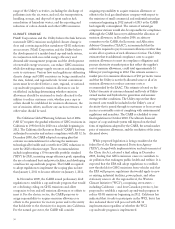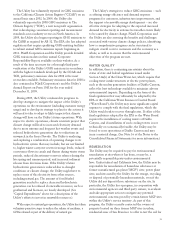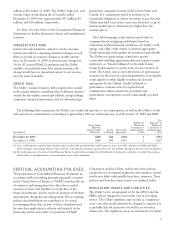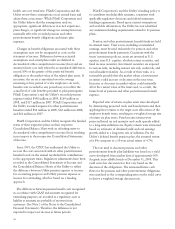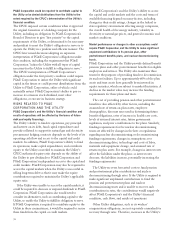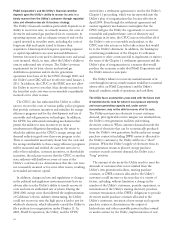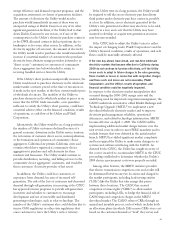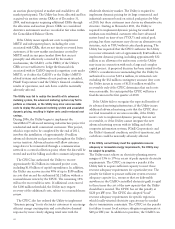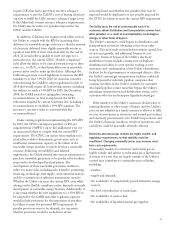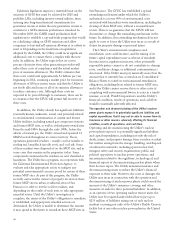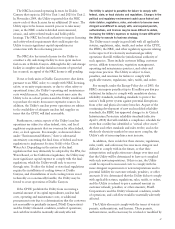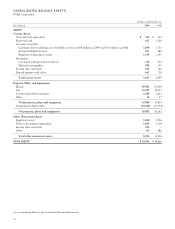PG&E 2009 Annual Report Download - page 44
Download and view the complete annual report
Please find page 44 of the 2009 PG&E annual report below. You can navigate through the pages in the report by either clicking on the pages listed below, or by using the keyword search tool below to find specific information within the annual report.PG&E Corporation’s and the Utility’s financial condition
depends upon the Utility’s ability to recover its costs in a
timely manner from the Utility’s customers through regulated
rates and otherwise execute its business strategy.
The Utility’s financial condition particularly depends on its
ability to recover in rates, in a timely manner, the costs of
electricity and natural gas purchased for its customers, its
operating expenses, and an adequate return of and on the
capital invested in its utility assets, including the costs of
long-term debt and equity issued to finance their
acquisition. Unanticipated changes in operating expenses
or capital expenditures can cause material differences
between forecasted costs used to determine rates and actual
costs incurred, which, in turn, affect the Utility’s ability to
earn its authorized rate of return. The Utility’s revenue
requirements for its basic electric and natural gas
distribution operations and its electric generation
operations have been set by the CPUC through 2010, and
the Utility’s next GRC will not be effective until January 1,
2011. In addition, the CPUC or the FERC may not allow
the Utility to recover costs that it has already incurred on
the basis that such costs were not reasonably or prudently
incurred or for other reasons.
The CPUC also has authorized the Utility to collect
rates to recover the costs of various public policy programs
that provide customer incentives and subsidies for energy
efficiency programs and for the development and use of
renewable and self-generation technologies. In addition,
the CPUC has authorized ratemaking mechanisms that
permit the utilities to earn incentives (or incur a
reimbursement obligation) depending on the extent to
which the utilities meet the CPUC’s energy savings and
demand reduction goals over three-year program cycles.
There is considerable uncertainty about how the costs and
the savings attributable to these energy efficiency programs
will be measured and verified. As customer rates rise to
reflect these subsidies, customer incentives, or shareholder
incentives, the risk may increase that the CPUC or another
state authority will disallow recovery of some of the
Utility’s costs based on a determination that the costs were
not reasonably incurred or for some other reason, resulting
in stranded investment capital.
In addition, changes in laws and regulations or changes
in the political and regulatory environment may have an
adverse effect on the Utility’s ability to timely recover its
costs and earn its authorized rate of return. During the
2000–2001 energy crisis that followed the implementation
of California’s electric industry restructuring, the Utility
could not recover in rates the high prices it had to pay for
wholesale electricity, which ultimately caused the Utility to
file a petition for reorganization under Chapter 11. In
2003, PG&E Corporation, the Utility, and the CPUC
entered into a settlement agreement to resolve the Utility’s
Chapter 11 proceeding, which was incorporated into the
Utility’s plan of reorganization that became effective in
April 2004. Even though the settlement agreement and
current regulatory mechanisms contemplate that the
CPUC will give the Utility the opportunity to recover its
reasonable and prudent future costs of electricity and
natural gas in its rates, the CPUC may not find that all of
the Utility’s costs are reasonable and prudent, or the
CPUC may take actions or fail to take actions that would
be to the Utility’s detriment. In addition, the bankruptcy
court having jurisdiction of the Chapter 11 settlement
agreement or other courts may fail to implement or enforce
the terms of the Chapter 11 settlement agreement and the
Utility’s plan of reorganization in a manner that would
produce the economic results that PG&E Corporation and
the Utility intend or anticipate.
The Utility’s failure to recover any material amount of its
costs through its rates in a timely manner would have a material
adverse effect on PG&E Corporation’s and the Utility’s
financial condition, results of operations, and cash flows.
The Utility faces uncertainties associated with the future level
of bundled electric load for which it must procure electricity
and secure generating capacity and, under certain
circumstances, may not be able to recover all of its costs.
The Utility must procure electricity to meet customer
demand, plus applicable reserve margins not satisfied from
the Utility’s own generation facilities and existing
electricity contracts. When customer demand exceeds the
amount of electricity that can be economically produced
from the Utility’s own generation facilities plus net energy
purchase contracts (including DWR contracts allocated to
the Utility’s customers), the Utility will be in a “short”
position. When the Utility’s supply of electricity from its
own generation resources plus net energy purchase
contracts exceeds customer demand, the Utility is in a
“long” position.
The amount of electricity the Utility needs to meet the
demands of customers that is not satisfied from the
Utility’s own generation facilities, existing purchase
contracts, or DWR contracts allocated to the Utility’s
customers could increase or decrease due to a variety of
factors, including, without limitation a change in the
number of the Utility’s customers, periodic expirations, or
terminations of the Utility’s existing electricity purchase
contracts termination of the DWR’s obligations to provide
electricity under purchase contracts allocated to the
Utility’s customers; execution of new energy and capacity
purchase contracts; fluctuation in the output of
hydroelectric and other renewable power facilities owned
or under contract by the Utility; implementation of new
40


